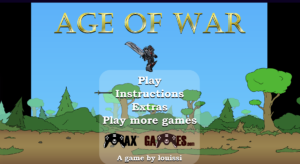Critical Play: Is this game balanced? – Age of War
Basic Information
Name of game: Age of War
Creator (Developer): Plarium
Platform: Played on browser of PC/Mac at https://www.crazygames.com/game/age-of-war; can also be played on Android or iOS through an app
Target Audience: Presumably children age 12+ who are easing into games that portray violence
Formal Elements of the Game
- Players
Age of War is a single-player game, with an interaction pattern of Single Player vs Game. There are no other human players; instead, the player must defeat an artificial, computer-powered enemy.
2. Objectives
The primary objectives of this game are Capture and Construction.
First and foremost, the player’s goal is to “survive and destroy the enemy base” while avoiding having their own base destroyed by the enemy – a common goal for games with the objective of Capture.
In order to strive towards this objective, the player must also possess the additional objective of Construction. The player must also build defenses to protect their own base from incoming enemy units.
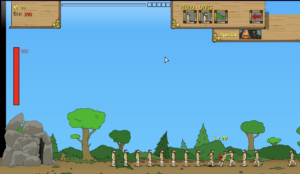
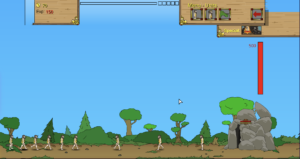
3. Outcomes
There are two outcomes to this game:
- The player wins: successfully destroys the enemy’s base first while protecting their own base.
- The player loses: the player’s base is destroyed by the enemy first.
In either outcome, the game is stopped and the player must start a new game if they wish to continue playing.
4. Procedures
Detailed instructions of the game are found here. In summary:
The game consists of five different stages of evolution (what we will call ages). At each age, new and more powerful technologies for offense and defense are available for purchase. The five ages are the following:
- Stone age
- Castle age
- Renaissance age
- Modern age
- Future age
To advance to the next age, the player must reach a threshold of XP points. XP points can be gained by defeating enemy units. The player also gain XP points when one of their own units is killed.
Defeating enemy units also earns the player currency. This currency can be used to purchase units for attacking the enemy units and base, or defensive weapons and turrets to fortify and further protect the base.
Finally, the player is able to use a “special attack” (different for each age of the game), which is meant to be used at moments when the player feels that their base is being overwhelmed by advancing enemy units.
5. Rules
When sending units off to attack the enemy base, the units must stand in a single-file line. Although units with long-range weapons can harm enemy units from a short distance, all other units can only damage the enemy units directly in front of them. Additionally, defensive weapons can only harm enemy troops when they draw close enough to the player’s base. Finally, the special attack can only be used sparingly; each time it is used, the player must wait until it has “recharged” before it is available again.
6. Resources
The primary resources of this game are XP points (necessary for evolving to the next age) and currency (required for purchasing units and defensive weapons).
The secondary resources of this game are the things that the player can buy with the currency. The broad categories of purchase stay constant across all ages, andinclude units, defensive weapons, and additional turret spots.

Finally, the most important resource of the game that must be protected is the health of the base (quantified through a health bar).
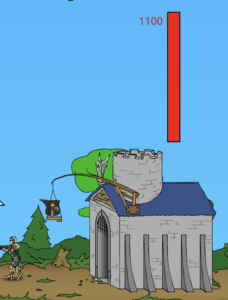
7. Boundaries
The most prominent boundary in this game is the virtual space that the game takes place in. The two bases are located at a fixed distance across opposite ends of a screen, which is where all the action must lie.
Another boundary is that the player can only gain a limited number of XP points and units of currency at a time. The player is also bounded for time by the continuously incoming units of the enemy.
Aesthetics of Fun
The intended aesthetics of fun in this game are primarily Challenge and Fantasy. The game was successful in meeting these goals through the design of its Formal Elements.
Firstly, the interaction pattern of Player vs Game enables the player to immerse themself fully into the challenge of strategizing a way to destroy the computerized enemy while protecting their own base. Since the enemy is powered by a computer, it can adjust its level of difficulty to ensure that the game does not end too early (for example, by sending more enemy troops if the player is too close to winning) and serves as an adequate Challenge to the player. Further, having no additional human players involved with this interaction pattern allows the user to become fully immersed in the fantastical world of this game with no human distractions, furthering the aesthetic of Fantasy.
The Capture and Construction objectives of the game (described in more detail above) feeds directly into the aesthetic of Challenge, as the player must strategize the best ways to capture the enemy’s base while managing their resources and defending their own base. This objective also furthers the Fantasy aesthetic, as the goal of conquest, occupation, and defense achieved through brave, loyal units and creative weaponry is one tied into every age that the game emulates and attempts to draw the player into. Further, the polar, high-stakes Outcomes of this game (either taking over the enemy’s base and winning or getting demolished by enemy forces and losing) motivates competition and a strong desire to win in the player, furthering the success of the aesthetic of Challenge.These Outcomes also align with narratives commonly found in fantasies, where parties enter into fierce and epic combat and one emerges the victor, furthering the Fantasy aesthetic.
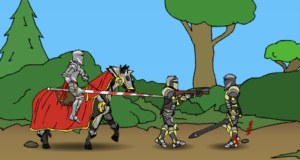
The Procedures and Rules, combined with the Resources granted to the player, enable the player to quickly understand what materials are at their disposal and how they may be used when it comes to trying to Capture the enemy and Construct defenses. At each age of the game, there are always three types of units to purchase and three types of defensive weapons to purchase at a range of prices, furthering the Challenge of deciding which ones are best to invest in at the moment (would it be better to purchase a few expensive units, or several less expensive ones?).The visual evolution of Resources available for purchase to the player (i.e. the progression of units from cavemen to knights to robots) contributes significantly to the Fantasy aesthetic of the game by carrying the chronological transitions between ages. Further, the separation between XP points and currency, as well as the fact that the player gains XP points when one of their own units is killed, forces the player to optimize for accumulating more of both, furthering the Challenge aesthetic as this is not easy to do. Moreover, the fact that the player can only use the special attack feature sparingly adds an extra element of Challenge to the game, as it requires the player to carefully consider and weigh the best time to sacrifice it.
Finally, the Boundaries of this game in terms of limited virtual space and time for making purchasing decisions furthers the aesthetic of Challenge. These Boundaries force the player to think on their feet and make quick, critical decisions on what to use their resources for to strategize a victory for the game.
Moments of Particular Success or Epic Fails
One moment of particular success was when I used special attack for the very first time during the Stone Age stage. To my delight, I saw great flaming balls of stone rain down and demolish enemy units. The surprisingly powerful impact of this attack made me itching to want to use it again, especially in the following ages, just to see what the different special attacks were. The special attack feature is a great addition to the game that furthers the themed fantasy aesthetic, while also giving the player another resource to strategize with.
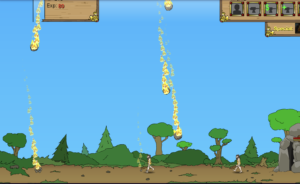
A moment of epic fail in this game was when I already had enough XP to well surpass the threshold for upgrading to the next age, but simply did not notice due to how subtly this information is displayed on the UI of the game. Another moment of epic fail was when I felt like I was just sitting around twiddling my thumbs and waiting for my units to slowly fight the other units, given the constraint that the units could only fight each other 1:1 in a single file line.

Suggested Improvement for the Game
To address the problem of a player failing to realize that they are able to upgrade to the next age, I would suggest the following UI improvement; every time a player has enough XP to upgrade, a notification should appear, alerting the player that this option is available. This shouldn’t detract from either of the aesthetics, as it does not take away from the objectives of Capturing or Constructing. I would also suggest modifying the game so that more than one player at a time from either side can fight each other, as this would allow more action and make the game feel less slow. Alternatively, there could be a settings option where players can adjust the game speed.
How game balance is responsible for the game experience
Based on the “4” Types of Game Balance: **
- The challenge level is appropriate for the audience. At the very beginning of the game, the player is able to choose the desired level of difficulty for the game. Although I’ve only played at the “Normal” level of the game, the game is very manageable but still challenging. As described in the Formal Elements and Aesthetics of Fun analyses above, the various components and considerations that must be taken into account in this game successfully feed into its aesthetic of Challenge. The fact that there are additional difficulty settings only further accommodates the challenge levels of a wider range of audiences.
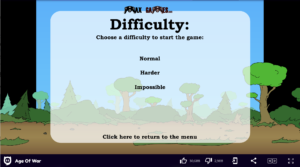
2. There are multiple strategies and paths to victory with no path obviously better than the others. This game is all about finding the ultimate balance between investing in defense or offense. There are many ways to win the game, whether the strategy leans more towards building a stronger defense or offense, there is no dominant strategy. With choices of action to be made at every moment of the game (which units or defenses to purchase and when) there is no particular option that is known to be better than the others.
3. Similar cost/benefit ratios between similar game objects. In this game, players can purchase a variety of units and defense weapons at every age of the game. Each item is a different price, with the more expensive units and turrets able to do more damage. As a result, the tradeoffs between using different game objects are non-obvious, as it is often not clear when a player should buy as many of the least expensive units as possible, or save up and purchase a more expensive resource to do more damage but with a costly delay. Further, the lowest damage objects are powerful enough to make tangible impact, while the objects with the ability to create the most damage are still very much defeatable.
** Balance is Asymmetric Games was skipped because this game is single-player.


